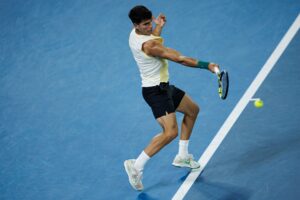After several years in the doldrums, Italian tennis is in the ascendancy again. First, Turin successfully secured the rights to succeed London as the host city of the ATP Tour Finals from 2021 to 2025 (at least). Then, the fabulous Fabio Fognini, the great modern-day Italian master of clay-court tennis, won the biggest title of his career, when he triumphed in Monte Carlo (in the process vanquishing the King of Clay himself, Rafael Nadal, in the semi-finals) to become the first Italian man to win a Masters 1000 title. So, with tennis back with a bang in Italy, it seems appropriate to preview the forthcoming Italian Open (Monday 6 May to Sunday 19 May) by looking back at the history of Italian tennis.
ORIGINS (INCLUDING THE INFLUENCE OF MUSSOLINI)
When Chris Kermode, the outgoing ATP President, made the recent announcement that the ATP Tour Finals are moving to Turin, he said that “Italy provides us with one of the strongest and most established tennis markets in Europe”. However, Italy is neither one of the traditional European tennis superpowers (such as England or France) nor one of its newer superpowers (such as Spain). In Italy, football, or calcio, has always reigned supreme (like many other countries, Italy even claims to have invented football, in the form of Florence’s early version of the game, Calcio Storico Fiorentino). As a result, other sports, such as tennis, have struggled to compete with football’s apparently complete annexation of the Italian sporting imagination.
Historically, Italy followed the lead of other European countries, notably France, in adapting the original format of tennis developed in England at the end of the 19th century, which was played on verdant lawns, to play the game instead on the clay (or crushed stone or brick) that is more common than grass in much of southern Europe and the Mediterranean.
However, whereas in France in particular tennis had become a national sporting obsession by the 1920s, in the wake of the remarkable success of first Suzanne Lenglen and then the Davis Cup-winning Musquetaires, in Italy tennis remained a relatively niche sport, largely played in the various “cricket and tennis” clubs that had been set up at the end of the 1800s by English expatriates.
The Italian Open (the male version of which is also known as the Rome Masters) was established in 1930 and one of its founding fathers, as it were, was none other than Il Duce himself, Benito Mussolini. Mussolini’s grand ambition, of course, was to create a new “Roman Empire”, and that included sporting success to compare with the chariot races and other games of imperial Rome. Consequently, he ordered the construction in the Italian capital of the Foro Mussolini, an enormous and classically-styled sporting complex, in the hope of winning the right to host the 1940 Olympics.
Of course, World War Two rather got in the way of that, but the Foro Mussolini, which was renamed the Foro Italico soon after Mussolini’s fall from power, remains the home of the Italian Open. It is also effectively the spiritual heart of Italian tennis, in the same way that Wimbledon and Roland Garros are the centrepieces of English and French tennis respectively.
THE GENIUS OF NICOLA PIETRANGELI
For all his considerable achievements as a tennis player in the post-war era, Nicola Pietrangeli, who remains arguably the greatest Italian tennis player of either gender, had largely been forgotten, at least in the Anglophone tennis world of England, America and Australia, until the emergence of one Roger Federer in the early 21st century. The reason that Federer’s rise led to a renewal of interest in the achievements of Pietrangeli was that many seasoned tennis commentators and historians saw much of Pietrangeli’s game in that of the great Swiss, in particular in the sheer elegance and elan with which Federer played tennis, and both men deployed a glorious single-handed backhand. For many older tennis fans, Federer was Pietrangeli reborn, or “rebooted”, for a new millennium.
Pietrangeli only won two Majors (the 1959 and 1960 French Opens) to Federer’s twenty, but statistics alone could never encompass the sheer shot-making genius of either man. As a result of that ability, both men completely captured the hearts and minds of the Parisian crowds, who are certainly the most knowledgeable (if demanding) clay-court crowds in the world. And Pietrangeli not only achieved individual glory but inspired Italy to their first two Davis Cup finals in 1960 and 1961. Unfortunately, on both occasions his Italian team were crushed by the then-dominant Australian side of Laver, Emerson et al, on the grass courts of Sydney and Melbourne respectively.
Nevertheless, to this day Pietrangeli (who, ironically, was born in Tunisia and not in Italy itself) remains not just the only Italian tennis player of either gender to have won more than one Major but unarguably the most graceful and skillful Italian tennis player ever.
ADRIANA PANATTA AND ITALY’S SOLE DAVIS CUP TRIUMPH
Pietrangeli’s successor as the best Italian tennis player was Adriana Panatta, a native Roman whose father had actually been the caretaker at the tennis club where he learned to play. Like Pietrangeli, and indeed like almost all of the great Italian male and female tennis players, Panatta grew up on clay and remained a clay-court specialist for his entire career.
Unlike Pietrangeli, Panatta only won one Major, the 1976 French Open, when he beat the then utterly dominant Bjorn Borg in the quarterfinals and went on to win the whole tournament. However, he did succeed where Pietrangeli had failed in leading Italy to what remains the country’s only Davis Cup triumph, when they beat Chile in Santiago, also in 1976. As a result, that year is not only the highpoint of Panatta’s own career but arguably the high-point of Italian tennis as a whole.
THE RISE OF ITALIAN WOMEN
It was more than three decades before Italy produced another Major winner, and then it was an Italian woman who became a Grand Slam champion. Francesca Schiavone, yet another clay-court specialist, capped a fine career by winning the 2010 French Open, defeating Australia’s Sam Stosur in straight sets in the final.
Then, having waited nearly a century for its first female Major winner, Italy only had to wait another five years for its next one, when Flavia Pennetta won the 2015 US Open. Remarkably, there was an all-Italian Final that year, as Pennetta defeated her compatriot, Roberta Vinci, after Vinci had somehow stopped Serena Williams from winning the calendar (i.e. genuine) Grand Slam by beating her in the semi-final, in what remains one of the greatest ever upsets in the entire history of tennis.
FABIO FOGNINI – AND THE FUTURE FOR ITALIAN TENNIS
It was entirely appropriate that Fabio Fognini won the biggest title of his career recently at Monte Carlo, the most beautiful tennis court in the world, because for a long time Fognini has been one of the most stylish, if not downright beautiful, clay-court players in the world. If it were not for the complete domination of clay-court tennis by Rafael Nadal for the last decade and a half, Fognini would surely at least have reached the Final of the French Open, if not won it.
Consequently, Fognini must have derived enormous satisfaction from his complete destruction of Nadal in the Monte Carlo semi-final, even if he could not quite “claygel” (bagel on clay) the Spaniard in the second set, which he eventually won 6-2. Emboldened by his triumph on the shores of the Mediterranean, perhaps Fognini can finally make a sustained run at Roland Garros and challenge Nadal again in the greatest clay-court tournament of them all.
However, Fognini is already 31 and so it is unlikely that he will make any of the ATP Tour Finals to be held in Turin between 2021 and 2025. (After winning in Monte Carlo, he is currently at his highest ever world ranking of No. 12, but even that would not be enough to get him to the end-of-season extravaganza, which is reserved for the top eight players in the world.) So the hope in Italy is that, before too long, another great male Italian player can emerge to follow in the footsteps (and footprints left on clay) of Pietrangeli, Panatta and Fognini. If that happens, then all of Italy can dream that one day in the 2020s an Italian man might just triumph in Turin.
Main Photo:






